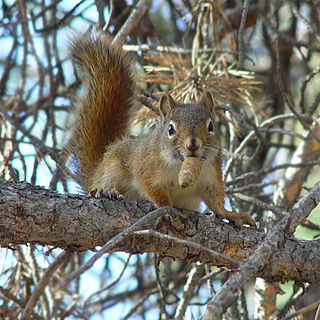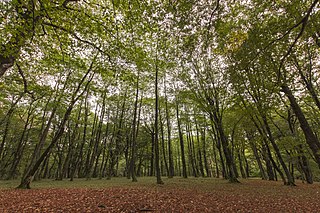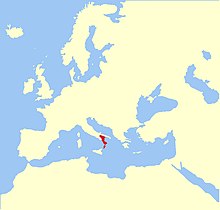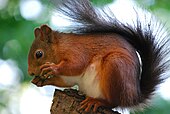
Sciurinae is a subfamily of squirrels, uniting the flying squirrels with certain related tree squirrels. Older sources place the flying squirrels in a separate subfamily (Pteromyinae) and unite all remaining sciurids into the subfamily Sciurinae, but this has been strongly refuted by genetic studies.

Pine squirrels are squirrels of the genus Tamiasciurus, in the Sciurini tribe, of the large family Sciuridae.

The eastern gray squirrel, also known, particularly outside of North America, as simply the grey squirrel, is a tree squirrel in the genus Sciurus. It is native to eastern North America, where it is the most prodigious and ecologically essential natural forest regenerator. Widely introduced to certain places around the world, the eastern gray squirrel in Europe, in particular, is regarded as an invasive species.

The red squirrel or Eurasian red squirrel is a species of tree squirrel in the genus Sciurus common throughout Europe and Asia. The red squirrel is an arboreal, primarily herbivorous rodent.

The genus Sciurus contains most of the common, bushy-tailed squirrels in North America, Europe, temperate Asia, Central America and South America.

The Brazilian squirrel is a tree squirrel in the genus Sciurus endemic to South America. It is found in South-eastern Colombia, Brazil, Guyana, French Guiana, Suriname and Venezuela.

The yellow-throated squirrel is a tree squirrel in the genus Sciurus endemic to South America. It is found in Brazil, Guyana and Venezuela.

The fiery squirrel is a rodent in the family Sciuridae. The taxon is endemic to the area south of the Orinoco River in the state of Bolívar, Venezuela.

The Japanese squirrel is a tree squirrel in the genus Sciurus endemic to Japan. It was described by Dutch zoologist Coenraad Jacob Temminck in 1844. The Japanese squirrel's native range includes large portions of the islands of Honshū, Shikoku, and Kyūshū. The Japanese squirrel is absent from Hokkaido, where it is replaced by the related red squirrel, which is conversely absent from the rest of the Japanese archipelago outside Hokkaido. Recently, populations in south-western Honshū and Shikoku decreased, and those on Kyūshū disappeared. One of the factors affecting the recent local extirpations of this species seems to be forest fragmentation by humans.

Peters's squirrel is a tree squirrel in the genus Sciurus endemic to Mexico. It was first described by the German naturalist and explorer Wilhelm Peters in 1863. Three subspecies are recognised. It is a common species, and the IUCN has rated its conservation status as being of "least concern".

The Andean squirrel is a tree squirrel endemic to Colombia where it inhabits montane rain forest and cloud forests of the Cordillera Occidental and Cordillera Central ranges of the Colombian Andes, at elevations between 2,000 and 3,300 metres. It is a small species with a body length of about 14 cm (6 in) and a similar length tail. It has soft, silky, reddish-brown fur, a darker tail and yellowish-grey underparts. It is thought to be diurnal but has been little studied, and the International Union for Conservation of Nature has rated its conservation status as being data deficient.
Sanborn's squirrel is or was a little known tree squirrel described in 1944 from the skin and skeleton of a single female specimen collected in Peru in 1941. Subsequently, over the proceeding years only a handful of either specimens were collected, or observations were recorded, in the regions of Madre de Dios and northern Puno in Peru, and Pando department in Bolivia. The 2019 IUCN assessment describes it as endemic to Peru. In 2015 this taxon was synonymised with Notosciurus pucheranii ssp. boliviensis. Its habitat is tropical dry broadleaf forests at elevations up to 570 m. It is considered possibly rare and potentially vulnerable to deforestation, but its population trend is not established.
The Calabria pine vole is a vole found in southern and central Italy initially described by Lehmann as a subspecies of M. savii. Genetic tests in the Calabrian region found, although similar, the X chromosome is larger than that of samples of M. savii found elsewhere in Italy and the Y chromosome is twice the size, leading Galleni in 1994 to designate M. brachycercus as a separate species.
The Mammalia in the 10th edition of Systema Naturae forms one of six classes of animals in Carl Linnaeus's tenth reformed edition written in Latin. The following explanations are based on William Turton's translations who rearranged and corrected earlier editions published by Johann Friedrich Gmelin, Johan Christian Fabricius and Carl Ludwig Willdenow:
Animals that suckle their young by means of lactiferous teats. In external and internal structure they resemble man: most of them are quadrupeds; and with man, their natural enemy, inhabit the surface of the Earth. The largest, though fewest in number, inhabit the ocean.

Europe's grey squirrels originated in North America, where they are known as eastern gray squirrels. They eat large seeds, flowers, buds, fruits, fungi, some insects and occasionally bird eggs.
Black squirrel may refer to:

Ajameti Managed Reserve is a protected area in the Baghdati Municipality, Zestafoni Municipality region of Georgia. It protects famous oaks of Ajameti and other local flora. Some of the trees are from 120 to 200 years old. Reserve also protects local fauna.

















